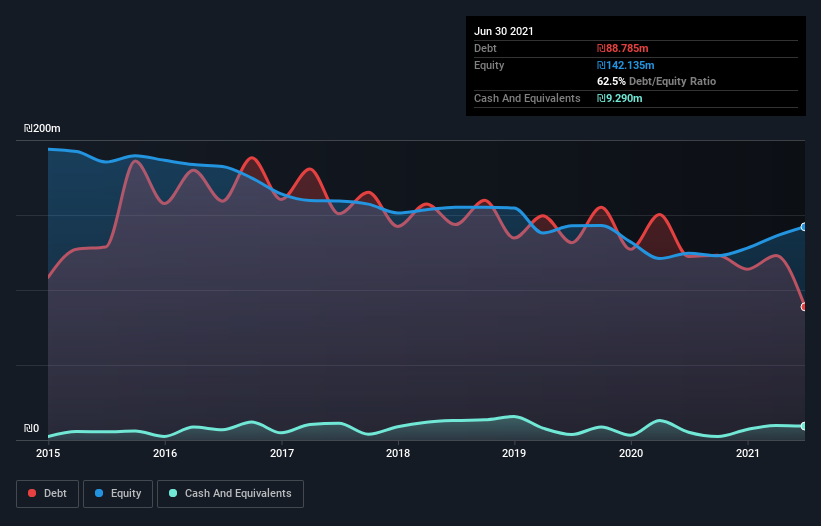Brill Shoe Industries (TLV:BRIL) Has A Pretty Healthy Balance Sheet
Warren Buffett famously said, 'Volatility is far from synonymous with risk.' It's only natural to consider a company's balance sheet when you examine how risky it is, since debt is often involved when a business collapses. Importantly, Brill Shoe Industries Ltd. (TLV:BRIL) does carry debt. But the real question is whether this debt is making the company risky.
What Risk Does Debt Bring?
Debt is a tool to help businesses grow, but if a business is incapable of paying off its lenders, then it exists at their mercy. Part and parcel of capitalism is the process of 'creative destruction' where failed businesses are mercilessly liquidated by their bankers. However, a more usual (but still expensive) situation is where a company must dilute shareholders at a cheap share price simply to get debt under control. Having said that, the most common situation is where a company manages its debt reasonably well - and to its own advantage. When we examine debt levels, we first consider both cash and debt levels, together.
View our latest analysis for Brill Shoe Industries
How Much Debt Does Brill Shoe Industries Carry?
As you can see below, Brill Shoe Industries had ₪88.8m of debt at June 2021, down from ₪122.4m a year prior. However, it also had ₪9.29m in cash, and so its net debt is ₪79.5m.

How Strong Is Brill Shoe Industries' Balance Sheet?
The latest balance sheet data shows that Brill Shoe Industries had liabilities of ₪148.7m due within a year, and liabilities of ₪205.5m falling due after that. Offsetting these obligations, it had cash of ₪9.29m as well as receivables valued at ₪114.4m due within 12 months. So its liabilities total ₪230.5m more than the combination of its cash and short-term receivables.
This deficit is considerable relative to its market capitalization of ₪250.0m, so it does suggest shareholders should keep an eye on Brill Shoe Industries' use of debt. Should its lenders demand that it shore up the balance sheet, shareholders would likely face severe dilution.
We use two main ratios to inform us about debt levels relative to earnings. The first is net debt divided by earnings before interest, tax, depreciation, and amortization (EBITDA), while the second is how many times its earnings before interest and tax (EBIT) covers its interest expense (or its interest cover, for short). Thus we consider debt relative to earnings both with and without depreciation and amortization expenses.
Looking at its net debt to EBITDA of 1.2 and interest cover of 4.7 times, it seems to us that Brill Shoe Industries is probably using debt in a pretty reasonable way. But the interest payments are certainly sufficient to have us thinking about how affordable its debt is. Pleasingly, Brill Shoe Industries is growing its EBIT faster than former Australian PM Bob Hawke downs a yard glass, boasting a 981% gain in the last twelve months. The balance sheet is clearly the area to focus on when you are analysing debt. But it is Brill Shoe Industries's earnings that will influence how the balance sheet holds up in the future. So when considering debt, it's definitely worth looking at the earnings trend. Click here for an interactive snapshot.
But our final consideration is also important, because a company cannot pay debt with paper profits; it needs cold hard cash. So the logical step is to look at the proportion of that EBIT that is matched by actual free cash flow. Over the last three years, Brill Shoe Industries actually produced more free cash flow than EBIT. That sort of strong cash conversion gets us as excited as the crowd when the beat drops at a Daft Punk concert.
Our View
Happily, Brill Shoe Industries's impressive conversion of EBIT to free cash flow implies it has the upper hand on its debt. But, on a more sombre note, we are a little concerned by its level of total liabilities. Looking at all the aforementioned factors together, it strikes us that Brill Shoe Industries can handle its debt fairly comfortably. Of course, while this leverage can enhance returns on equity, it does bring more risk, so it's worth keeping an eye on this one. The balance sheet is clearly the area to focus on when you are analysing debt. However, not all investment risk resides within the balance sheet - far from it. Be aware that Brill Shoe Industries is showing 3 warning signs in our investment analysis , you should know about...
Of course, if you're the type of investor who prefers buying stocks without the burden of debt, then don't hesitate to discover our exclusive list of net cash growth stocks, today.
Valuation is complex, but we're here to simplify it.
Discover if Brill Shoe Industries might be undervalued or overvalued with our detailed analysis, featuring fair value estimates, potential risks, dividends, insider trades, and its financial condition.
Access Free AnalysisThis article by Simply Wall St is general in nature. We provide commentary based on historical data and analyst forecasts only using an unbiased methodology and our articles are not intended to be financial advice. It does not constitute a recommendation to buy or sell any stock, and does not take account of your objectives, or your financial situation. We aim to bring you long-term focused analysis driven by fundamental data. Note that our analysis may not factor in the latest price-sensitive company announcements or qualitative material. Simply Wall St has no position in any stocks mentioned.
Have feedback on this article? Concerned about the content? Get in touch with us directly. Alternatively, email editorial-team (at) simplywallst.com.
About TASE:BRIL
Brill Shoe Industries
Designs, manufactures, imports, procures, markets, and sells footwear and clothing products, and fashion accessories in Israel.
Good value with mediocre balance sheet.
Market Insights
Community Narratives



